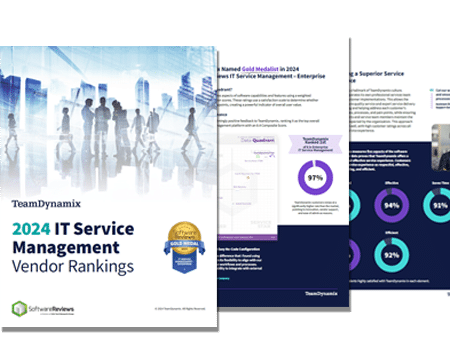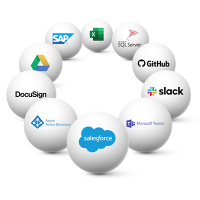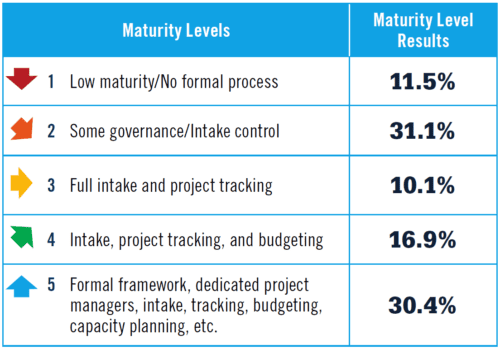
Paving the Way for Better IT Service with the Right ITSM Tool
The construction industry can be very volatile, with a high employee turnover rate due to seasonal fluctuations in the workforce. A key challenge for the

The Info-Tech ranking report offers a unique view of the market based entirely on in-depth customer interviews. Download the Info-Tech ITSM Quadrant and Customer Viewpoint report today.

We’ll show you some of our best situations and show you exactly how to execute them to get immediate results. The best part is, iPaaS tools often feature easy-to-use click and drag functionality, meaning you don’t need a dedicated employee building integrations and workflows.

System Integrators, Value Added Resellers, Technology Providers, and Buying Consortiums can benefit from a partnership with TeamDynamix.

The Info-Tech ranking report offers a unique view of the market based entirely on in-depth customer interviews. Download the Info-Tech ITSM Quadrant and Customer Viewpoint report to gain a better understanding of key vendor strengths and emerging market requirements.
Companies and organizations, no matter how big or small, can vary in project management and IT Service Management maturity. Even large, well-established companies can find themselves suffering from immature processes and workflows. In fact, a market study by ProjectManagement.com found that 42.6 percent of companies surveyed were worried that their organizations were operating at a low maturity level.
The study asked participants to use a scale of 1-5 to rank their perceived maturity level. The levels are as follows:
If you had to rank your business or organization today, where would you fall?
Organizations on the top end of the scale – those ranking themselves a four or five – are likely consistent when it comes to delivering projects successfully. While those ranking themselves on the lower end of the scale – the ones and twos – are probably struggling to deliver projects on time, within scope and on budget.
When asked what percentage of projects achieved business goals, organizations that ranked themselves at levels one and two on the maturity scale were six-and-a-half times more likely (14.3%) to have more than half of their projects fail versus a mere 2.2% of level five organizations. Those failed projects add up.

It’s no surprise that organizations at level one or level two also say they struggle to keep projects on schedule and on budget. On average, those surveyed reported more success with keeping projects on a budget (52.7%) than on schedule (41.9%), but when looking at the high and low ends of the scale, level five organizations were at least twice as likely to achieve these project outcomes when compared to level one and level two organizations.
The data shows that project governance (or lack thereof) seems to be the main predictor of projects’ success or failure. In addition, areas with the widest gaps between the two ends of the scale were resource capacity planning, formal project intake/governance review, and the existence of a proper project management office (PMO).
Not every organization needs to be a level five – in fact, the focus for most businesses and organizations with low maturity should be on improvement.
The 330,000 members of Kern Family Health Care, a Medi-Cal managed care health plan serving residents of Kern County, California, rely on high-quality service for their patient care. Delivering on this promise isn’t possible without an efficient project management team to administer the 30-plus active projects that Kern Health Systems has going at any given time.
Before TeamDynamix, Kern Health Systems was using another project management tool, but it wasn’t meeting the organization’s needs. For instance, the software did not offer the ability to manage projects within a portfolio.
LaVonne Banks, director of Kern Health Systems’ enterprise project management office (EPMO), wanted a flexible yet affordable project portfolio management (PPM) platform that could do both, without requiring separate software systems—and Banks and her team have discovered that TeamDynamix is just what the doctor ordered.
With a simple and intuitive user interface, TeamDynamix makes it easy for project managers to evaluate project requests, approve and prioritize initiatives, assign resources and track and report on progress. TeamDynamix helps EPMO staff keep projects on course, establish clear expectations, and allocate resources more effectively.
“With TeamDynamix, I always have a source of truth on project data,” Banks observes.
Using TeamDynamix brings greater transparency to the project management process. It also saves Banks and her staff a great deal of time when they want to understand the status of projects and report this to organizational leaders.
“I love the platform’s reporting features,” she says. “They’re super easy to use. Being able to pull reports and quickly see real-time data is wonderful.”
Another key benefit of TeamDynamix is that it helps EPMO staff get out ahead of potential issues before they become full-blown problems. While some challenges are beyond the control of project managers, having greater insight makes it more likely that projects will be completed on time and under budget.
“We can quickly identify resource constraints and make adjustments when unexpected circumstances arise,” Banks says. “Because we can identify these issues earlier, we have a better chance of staying on top of resource management.”
Better transparency leads to more accountability and, ultimately, a higher success rate on projects.
When you consider that project portfolio management tools can cost several times as much for similar features and functionality, “the value of TeamDynamix is incomparable,” Banks concludes.
By bringing IT Service Management (ITSM) and Project Portfolio Management (PPM) together on a single platform, you can better understand your resource capabilities and engage in true resource capacity planning.
With resource capacity planning you get a big-picture view of your entire IT organization, allowing you to balance workloads across projects and support; and to see the different types of work that need to be done at any given time.
For example, if you have three IT technicians that need to cover three functional areas of business – like service, projects and operations – you can engage in resource capacity planning and optimize each technician’s workload based on their skill set and their availability. As a result, the work can be completed more effectively and efficiently as each technician is focused on work that plays to their strengths. And because you have a full view of the work and the time it will take, you can avoid overcommitting or underutilizing your resources.
This approach is especially useful when you have limited resources, but an increase in demand for the support of remote learning and remote workforces. By having that single view of all projects and resources, companies are better equipped to face these challenges head-on.
To learn more about the heavy cost of low project management maturity, check out the TeamDynamix whitepaper with ProjectManagement.com.
To hear more about the importance of IT and project management maturity, watch this video about Boston College’s experience driving their maturity with TeamDynamix.
This post was originally published in December 2020 and has been updated with additional information.

The construction industry can be very volatile, with a high employee turnover rate due to seasonal fluctuations in the workforce. A key challenge for the

A study from Information Week and TeamDynamix shows companies are looking to invest in IT Service Management (ITSM) software that is simple to administer and

When it comes to improving IT Service Management (ITSM) maturity, many organizations turn to ITIL – a framework that guides users through a process-based approach
TeamDynamix’s award-winning SaaS cloud solution offers IT Service and Project Management together on one platform with enterprise integration and automation.
[email protected]
(877) 752-6196
Contact Us
